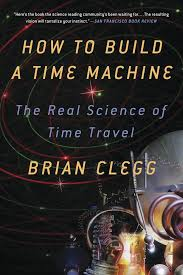How to Build a Time Machine: The Real Science of Time Travel by Brian Clegg

author brian clegg
Before beginning my review of this book I want to make it perfectly clear I have very little prior knowledge of quantum mechanics and physics that I used to inform my reading and that was my motivation to pick up Brian Clegg’s book. I love physics but hate math, which is a bad combination in the academic/practical world of physics. I do have the background of some college level physics, and that was enough for me to understand the concepts the way Clegg explains them in his book.
Unlike what the title suggests this book isn’t all about
theories on how time travel could be possible, in fact, most of these experiments and theories aren’t even talked about until over half way through the book. The first half of the book is spent discussing how theorists came to these modern day hypotheses. Clegg explores the science fiction that started it all, cover H.G. Wells’s
The Time Machine and the always popular t.v. show Dr. Who and then compares these methods of time travel to what we now know about physical time travel. He then starts to explore the early theories that led to current ones and spends a lot of time giving background on the scientists, a lot of which reminded me of my high school physics classes. But once you make it through that he begins to explore modern theories on the possibilities of time travel.

As many of the other reviewers have stated, this is a “pop science” book. It’s not for readers who already have an advanced knowledge of these physical theories. If you do…you’ll get bored with all the background. For someone like me, who’s looking to expand my knowledge of quantum mechanics and modern physics as a hobbyist, this book was a perfect combination. Clegg gives the reader enough background that you could (almost) pick up this book with no previous knowledge of physics and understand it. The sci-fi pop culture references, and anecdotes about scientists keep it from sounding like a journal article, and the theories he shares are interesting.
Overall I think to enjoy this book you need to come to it with the right attitude. This book is not written for readers who already have an extensive knowledge of the theories discussed. It’s made to help everyone else understand these concepts, as kind of a “dip your toe in the water” before diving into more science-heavy books.




